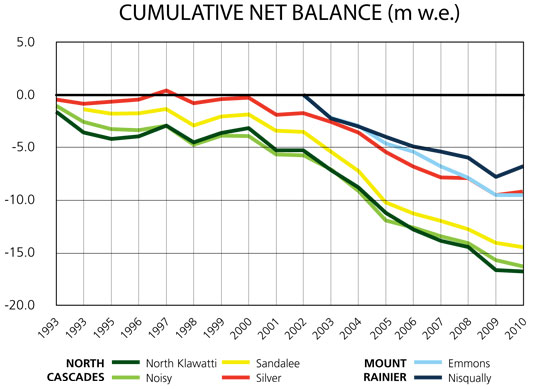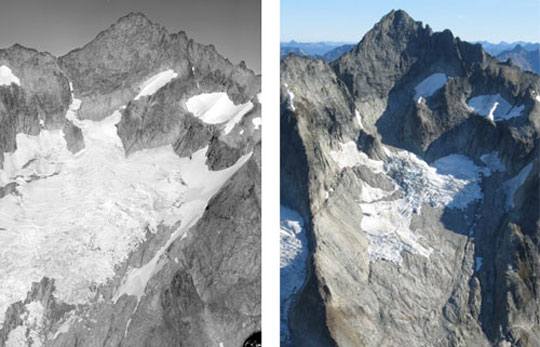North Cascades Resource Brief: Glaciers
 Since the last ice-age, glaciers have continued to shape the dramatic scenery and ecosystems of the North Cascades. Covering a combined area of 109 km² in North Cascades National Park Complex, they are integral components of the region’s hydrologic, ecologic, and geologic systems. Each summer glaciers provide billions of gallons of freshwater for drinking, irrigation, hydroelectricity, fishing, water-based recreation, and wildlife. Glacial melt water comes at a critical time of year when the weather is relatively hot and dry, buffering the region’s lakes and streams. On the Skagit river alone glaciers provide 8–12% of total summer runoff, or about 120–180 billion gallons. The sensitive and dynamic response of glaciers to variations in both temperature and precipitation in all seasons makes them excellent indicators of regional and global climate change.
Since the last ice-age, glaciers have continued to shape the dramatic scenery and ecosystems of the North Cascades. Covering a combined area of 109 km² in North Cascades National Park Complex, they are integral components of the region’s hydrologic, ecologic, and geologic systems. Each summer glaciers provide billions of gallons of freshwater for drinking, irrigation, hydroelectricity, fishing, water-based recreation, and wildlife. Glacial melt water comes at a critical time of year when the weather is relatively hot and dry, buffering the region’s lakes and streams. On the Skagit river alone glaciers provide 8–12% of total summer runoff, or about 120–180 billion gallons. The sensitive and dynamic response of glaciers to variations in both temperature and precipitation in all seasons makes them excellent indicators of regional and global climate change.
In 1993, the National Park Service began long-term monitoring of glacial mass balance of four glaciers at North Cascades National Park Complex. Monitoring includes seasonal field measurements of snow depth, density, and snow and ice melt which are used to calculate volume change or “mass balance”. Mass balance is the difference between winter accumulation (growth) and summer melt (loss).
Status and Trends
Small mountain glaciers are in rapid retreat throughout the world. At North Cascades National Park Complex, geologic mapping data and a 1998 inventory indicate that glacier area has declined approximately 50% in the last 100 years. Glacier mass balance measurements, since 1993 at the park provide a quantitative measure of the impact of climate change on glaciers. Between 1993 and 2010 all of the glaciers monitored at North Cascades National Park Service Complex have experienced significant reductions in volume, with a net loss of nearly 5 billion gallons of water.
In 2010, late season snow and a cool spring and summer helped glaciers build small increases in mass balance. Silver Glacier had a slightly positive net balance, the first in eight years. However, the remaining three monitored glaciers had more summer melt than winter accumulation.
Discussion
Rapid loss of glaciers in this network is unambiguous evidence of global warming, and reflects a pattern observed in mountain ranges around the world. Loss of this resource and the buffering it provides to aquatic ecosystems will complicate efforts to protect threatened and endangered aquatic species such as Chinook salmon and bull trout. Research using glacier monitoring data indicates that the loss of glaciers during the last century in Thunder Creek watershed at NOCA has resulted in a 25% decline in late summer stream flow. During the next century, glacier loss in this basin could reduce summer stream flow an additional 30%.
 Annual net mass balance of glaciers monitored at North Cascades and Mount Rainier National Parks. Units are meters water equivalent (m w.e.). Water equivalent expresses the different water contents of snow, ice and firm as a single value.
Annual net mass balance of glaciers monitored at North Cascades and Mount Rainier National Parks. Units are meters water equivalent (m w.e.). Water equivalent expresses the different water contents of snow, ice and firm as a single value.

